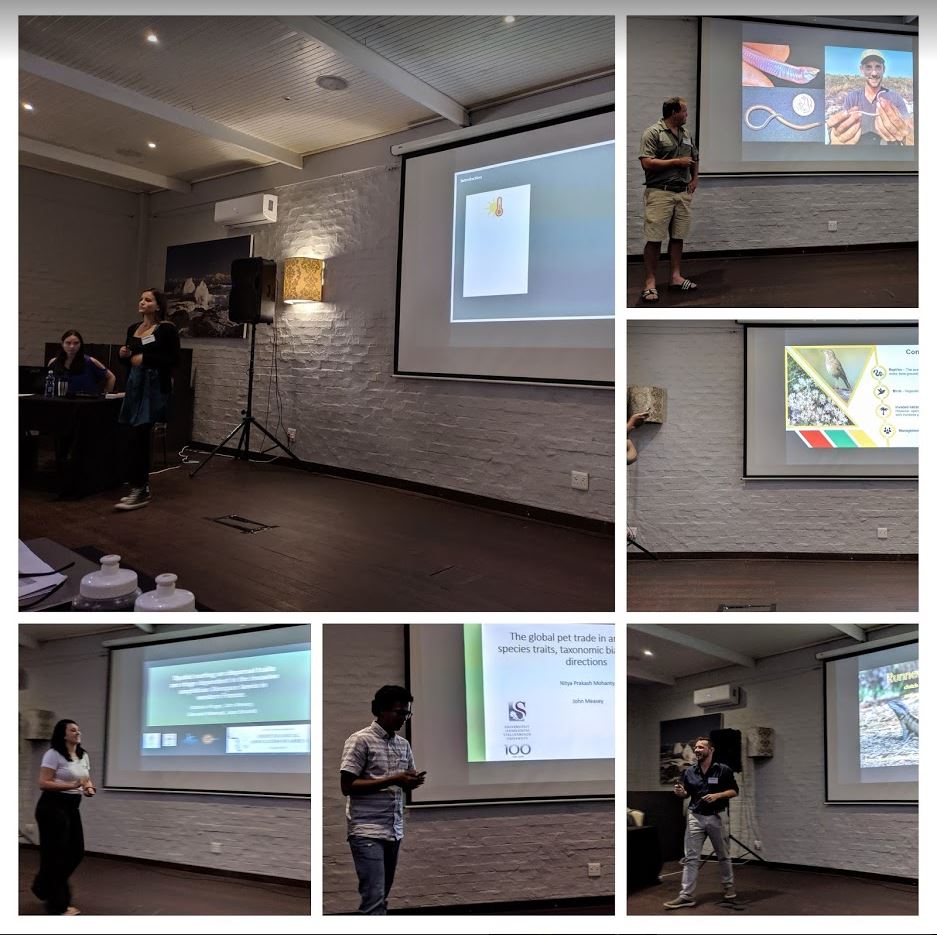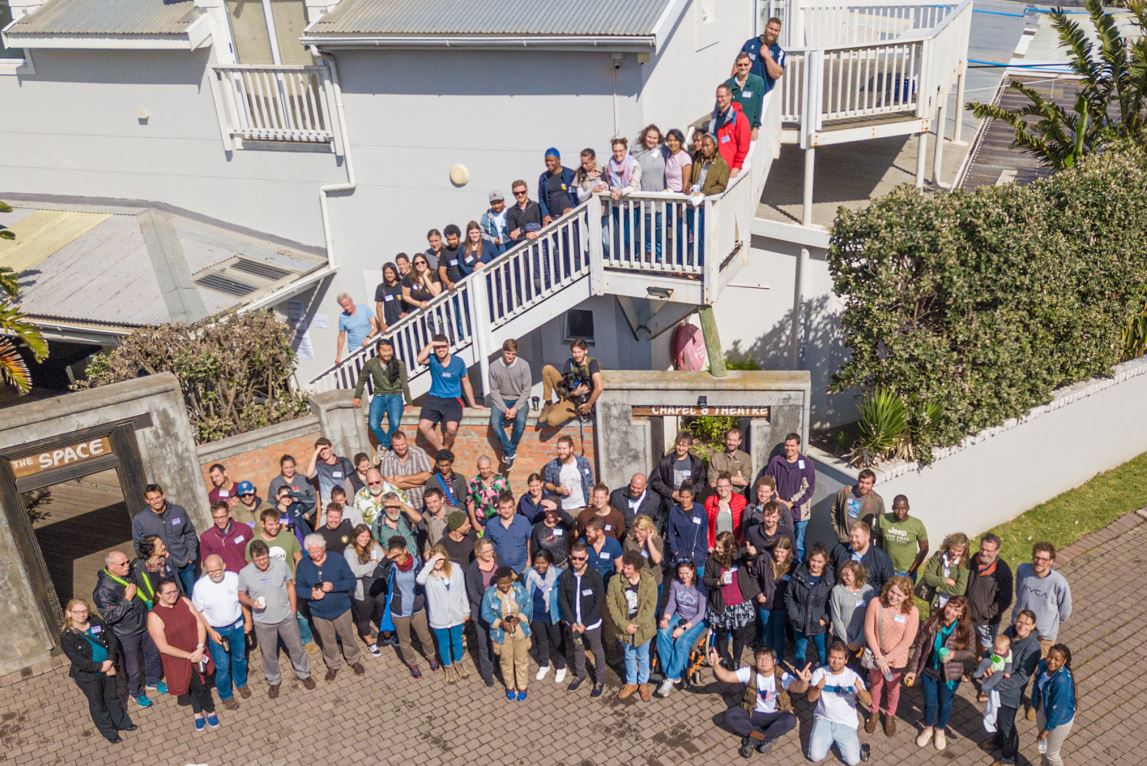The HAA meeting at Cape St. Francis, Eastern Cape
Only 8 hours drive from Cape Town, and we arrived at Cape St. Francis in the Eastern Cape to attend the Herpetological Association of Africa's 14th conference.
Of course, once we were there, we all gave stunning talks from many members of the MeaseyLab, both those based at Stellenbosch University and elsewhere. Nitya got a special surprise when the paper on which his talk was based was accepted in the session before he talked! Very welcome news indeed!
It was good fun to get to the beach, meet up with plenty of herpers that we knew and meet new ones that we didn't know. A special mention to Alan Channing who received the HAA's highly prized life-time achievement award for his contribution to southern African frog taxonomy. More than 20 years ago (1998), I worked with Alan at UWC during my first Royal Society post-doc (see here).
Here are some of the abstracts of the talks:
Kruger, N, Vimercati, G, Herrel, A, Secondi, J & Measey, J Spatial sorting on dispersal traits are stage dependent in the invasive amphibian Xenopus laevis in western France
Organisms are exposed to trade-offs constraining their anatomy, physiology, and behavior between dispersal and life-history traits. The spatial sorting theory predicts the enhancement of dispersal traits due to resource re-allocation at the periphery of expanding populations. A more nuanced view of spatial sorting emerges when one considers organisms with complex life cycles in which dispersal usually occurs at a particular ontogenic stage. It is currently not known if enhancement of dispersal traits in organisms with complex life cycle emerges only at the dispersal stage. In amphibians, larval development can influence life-history traits that directly influence dispersal in post-metamorphic juveniles. Spatial sorting for dispersal traits occurs in adults of the invasive African clawed frog, Xenopus laevis, in western France. Individuals have been expanding from a single introduction point since the 1980s colonizing an area of ~2000 km2. The mass of reproductive organs is reduced at the range periphery while the dispersal rate, probability and distance are increased. In X. laevis all stages are aquatic and dispersal is terrestrial. We predict that the enhancement or adaptation of dispersal traits due to spatial sorting occurs at the onset of their development regardless of dispersal ability of tadpoles. To test this, we conducted experiments in outdoor mesocosms and in microcosms in the lab. We surveyed tadpole development for 10 weeks from hatching to metamorphosis. We observed no effect of site position (core vs. periphery) on morphology, development, and survival of tadpoles. This study shows that spatial trait variation in pre-dispersal and dispersal stages are decoupled to a large extent in species with complex life cycles. In amphibians, tadpole development is constrained by factors such as initial density, food availability, and predation whereas in adults, resource allocation to dispersal can be enhanced at the dispersing stage and not at the pre-dispersal stage.
Measey, J, Baxter-Gilbert, J, Davies S, Kruger, N, Mohanty N How do herpetologists study invasions?
Invasion Biology is a young discipline, Charles Elton only coined the term in 1958. Although the subject was generally ignored by most people for 40 years, the last 20 years has seen a near exponential rise in papers by herpetologists on alien reptiles and amphibians (and not only by Rick Shine!). But how do herpetologists go about studying invasions? In this study, we reviewed 836 publications on alien herps and compared their objectives with 30 well known hypotheses from invasion biology. We found that although the field is rapidly expanding, very few researchers had specified any of the invasion hypotheses, but 26% had the data to test one or more. The most commonly tested hypothesis resembled the concept of the ‘ideal weed’, that invasion success of a non-native species depends on its specific traits (3.8%). Other popular hypotheses referred to habitat filtering (1.7%), preadaptation through human commensalism (1.8%), novel weapons (1.3%), novel associations (1.4%) and invasion meltdown (1.5%). Perhaps more excitingly, are the new hypotheses that herpetologists can donate to invasion biology, including spatial sorting, invasion hubs and hybridisation. We conclude that herpetologists need to pay more attention to existing hypotheses in invasion biology, many of which stem from classical questions in ecology. Better transdisciplinary communication will likely lead to increased impact of studies which could teach invasion biologists more about reptiles, amphibians and their amazing invasions.
Mohanty, N & Measey, J The global pet trade in amphibians: Species traits, taxonomic bias, and future directions
The burgeoning global pet trade in vertebrates has multi-pronged conservation implications, including overexploitation of native populations, spread of diseases, and invasions. The majority of amphibian invasions are due to the pet trade pathway and current lists of extra-limital amphibians (including those in trade) suggest that future invasions will encompass a broader taxonomic diversity than is known. Given that trade is dynamic, it is essential to move beyond currently traded species and understand which species are likely to be traded in the future and serve as candidates for invasions. In this study, we systematically assess amphibian species in the pet trade, i) characterising taxonomic bias, ii) evaluating species-traits as predictors of traded species and trade volume, and iii) forecasting likely future pets. We collated a global list of 443 traded amphibians and a regional dataset (USA) on trade volume. Species-traits (body size, native range size, clutch size, and breeding type) and conservation status, were considered as predictors of traded species and volume. Six Families contributed disproportionately to the amphibian pet trade; the likelihood for species to be traded was positively associated with body size, range size, and a ‘larval’ breeding type. However, species-traits performed poorly in predicting trade volume, suggesting an overriding effect of socio-economic aspects of the trade. The identified species-traits and taxonomic bias of the trade were then used to predict species likely to be traded as pets in the future. This study formalizes the knowledge on amphibian species that are traded as pets. We found a strong bias for certain Families, along with a preference for large-bodied and widely distributed species with a larval phase. Our results pave way for more trait-based approaches to forecast amphibians entering the trade. Such understanding of the pet trade can help pre-emptively tackle the pathway responsible for most invasions and disease spread in amphibians.
Peta, STP, Engelbrecht, GD & Measey, J Reptile and avian assemblage along a gradient of invasive alien plants in the critically endangered Woodbush Granite Grassland
Invasive alien plants species (IAPs) are a significant problem in South Africa and can pose complex and far-reaching challenges to biodiversity, with impacts on fauna poorly understood. The study aimed for multi-site comparison of reptile and bird assemblages between pristine grassland, alien plant invaded and plantation habitats. Reptiles and birds were surveyed using standard Y-shape trap array and fixed-point counts respectively. Vegetation structure and invasion intensity was determined using point-intercept method. Five IAPs were identified: Acacia mearnsii, Eucalyptus grandis, Pennisetum clandestinum, Pinus patula and Solanum mauritianum. Reptiles (23 individuals from 5 species) were recorded, with highest abundance and diversity in the grassland. Birds (2113 individuals from 67 species) showed the greatest abundance, diversity and richness in the invaded habitat. Trachylepis varia was a common reptile species, showing overlap between grassland and invaded habitat. Lygodactylus methuen was the only identified endemic reptile species. Grassland bird specialists (i.e. Anthus similis, Cisticola lais, and Sphenoeacus afer) were observed in more open and moderately invaded habitat but absent in denser and heavily invaded habitat. The study demonstrated that reptiles and birds respond differently to alien plants invasion. Reptiles were mostly supported by low vegetation cover, availability of microhabitats e.g. rocks and bare ground for thermoregulation while birds responded to rich vegetation stratification. Clearing of invasive alien plants can be considered as management strategy if it is to promote biodiversity. Clearing can create more thermal opportunities for reptiles and accommodate open habitat bird species.
Telford, N, Channing, A & Measey, J Origin of invasive populations of the Guttural Toad, Sclerophrys gutturalis
The Guttural toad, Sclerophrys gutturalis, has three established invasive populations on Mauritius, Reunion and in Constantia, a peri-urban area of Cape Town, South Africa. The native range of this toad covers much of central and southern Africa. Here we use mitochondrial DNA (mtDNA) to sample across the range of the natural distribution (from Kenya to South Africa) and compare ND2 and 16S sequences to those from animals sampled from each of the three invasive populations. We show that all invasive populations refer to the same mtDNA clade, which is naturally distributed in north-eastern South Africa, but not from adjoining Mozambique or southernmost Eastern Cape areas. Our findings corroborate previous reports of deliberate introductions from South Africa to Mauritius, and from Mauritius to Reunion. Similarly, our results suggest a single accidental translocation within South Africa from the northeast to Constantia. Our findings highlight the combination of anthropophilic behavior, and extreme long-distance dispersal occurring with accidental translocation for this species. We caution that accidental pathways are likely to continue into the future, with increasing numbers of invasive populations of this species.
Wagener, C, Kruger, N & Measey, J Xenopus laevis progeny display local adaptation of physiological performance to environmental extremes
Altitudinal variation of environmental temperatures is expected to shape the evolution of physiological functions of widespread populations. Adaptation to thermal extremes can create altitudinal differentiation in ectotherm physiological performance. In this study, a common garden experimental approach was employed to determine whether thermal adaptations to contrasting environmental regimes are heritable and how these thermal adaptations affect performance. To address this, we compared the critical thermal limits and swimming performance of African clawed frog (Xenopus laevis) tadpoles bred from two adult populations captured from high (~ 2000 m above sea level) and low (~ 5 m above sea level) altitudinal extremes. Parental-origin significantly affected tadpoles’ critical thermal minima (CTmin), maximum velocity, maximum acceleration, total distance and distance travelled in the first 200 m.s-1. Tadpoles with low-altitude parental-origins had a higher optimal temperature (Topt) for swimming performance and CTmin than tadpoles with high-altitude parental-origins. Performance of tadpoles bred from high-altitude adults was significantly higher at cooler temperatures and lower at the highest test temperature, in comparison with tadpoles bred from low-altitude adults. These results suggest that thermal performance curves of X. laevis tadpoles have adapted in response to contrasting local environmental conditions experienced by adults. Future studies should focus on whether similar thermal performance trait variations are present in other populations of the widely distributed African clawed frogs (X. laevis).
Jordaan, PR, Measey, J, Hanekom, CC, Greend, AN, Woolcocke, AB, Combrink, X Grassland and savanna fossorial herpetofaunal densities
Ecological data on soil living amphibians and reptiles are largely lacking. Specialised methods relying on substrate excavation are required to adequately quantify fossorial herpetofaunal densities as surveying techniques which rely on surface movement (e.g. pitfall or funnel trap surveys) are biased against soil-living species which infrequently move over the soil surface. As part of a larger study, we quantified baseline densities for fossorial herpetofauna in grassland at Sileza Nature Reserve and in savanna at Tembe Elephant Park. All sites were underlain by aeolian sand. Grassland surveys were conducted at two adjoining sites, one during summer, and one in winter while both savanna sites were only surveyed during winter. Quadrats of 4 m2 (2 m x 2 m) were excavated to a mean depth of 0.25 m (volume of 1 m3) as most species of fossorial herpetofauna are considered to live at shallow soil depths. The excavated substrate was momentarily stored in 20 litre buckets before being sifted through a 2 mm x 2 mm (4 mm2) metal mesh, exposing soil living reptiles and amphibians. Grassland fossorial herpetofaunal densities were marginally lower during winter (0.56 individuals.m-2) compared to the summer (0.67 individuals.m-2) survey. Grassland species richness consisted of a single amphibian, Breviceps mossambicus, as well as five reptile species. Although amphibian species richness was considerably lower in grassland compared to reptiles, densities were higher especially during summer. Inter-seasonal demographic variability was observed in the grassland amphibian population with higher numbers of juveniles present during the summer. Herpetofaunal fossorial densities at savanna sites were on average more than four times lower (0.11 and 0.14 individuals.m-2 respectively) compared to grassland. Once again, the only amphibian present was B. mossambicus, but in much lower densities (0.01 and 0.02 individuals.m-2). It is hoped that the outcomes of this study will contribute to a better ecological understanding of soil megafauna in grassland and savanna ecosystems.




